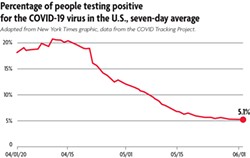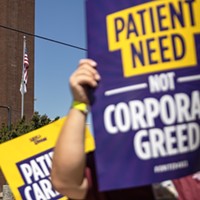[
{
"name": "Top Stories Video Pair",
"insertPoint": "7",
"component": "17087298",
"parentWrapperClass": "fdn-ads-inline-content-block",
"requiredCountToDisplay": "1"
}
]
I know, I know. Articles on myths about coronavirus have been done to death. Yet every day the Whack-a-Mole claims pop up again — conspiracy stories, China, Big Pharma, what to eat to prevent infection, the vaccine just around the corner ...
Here, I'll try to shine a light on some of the more prevalent erroneous stuff. Two caveats: (1) I'm not a scientist, I'm a writer, albeit one with several decades researching and sorting out valuable from worthless information; (2) this pandemic is a moving target and what's true today may not pan out tomorrow. If in doubt, do your own research — that's why God gave us the internet. The World Health Organization and the Centers for Disease Control are two trustworthy places to start.
Myth #1: Alcohol consumption kills the virus
Remember back in March when we were told to wash our hands regularly or — in the absence of a convenient sink — to use a 70 percent alcohol solution to disinfect our hands? It does indeed kill viruses and bacteria on your skin, although soap does a better job dismantling the fatty bag in which the virus' RNA hides. But I guess that recommendation somehow transmogrified into, "Drink lots of booze and you're good!" Doesn't work that way (sadly). The World Health Organization says alcohol plays no role in supporting the immune system to fight a viral infection, whether it's Two Buck Chuck or fancy Glenlivet. The booze doesn't wash over the lining of your lungs where the virus is gaining a toehold on your body — if it did, you'd choke to death. Worse, there's some evidence that too much alcohol may harm your immune system.
Myth #2: Bleach takes care of it
According to the Centers for Disease Control, nearly four in 10 American adults report cleaning food with bleach, using household disinfecting products on their skin or intentionally inhaling vapors from cleaning products as ways of staving off the virus. True, disinfectants help to eliminate germs on surfaces — not inside the body, though. There, they can cause serious harm. According to the Centers for Disease Control, calls to poison centers were up 20 percent compared to the same period last year, with a sharp increase in early March.
Myth #3: Summertime and the living will be easy
The common cold, caused by other coronaviruses, is more prevalent in winter than in summer, so there's some hope that warmer weather will slow down the pandemic. However, that hope may not hold with this novel virus — researchers point out that warmer places such as Singapore, India, Iran, Brazil and Louisiana have seen large outbreaks of COVID-19.
Myth #4: Blame it on 5G
Europe has seen a spate of attacks on 5G communication towers — 50 in the UK in April and more in the Netherlands, Ireland, Cyprus and Belgium. The claim is that radiation from 5G networks damages the human immune systems, or that 5G actually spreads the virus. It doesn't: The virus is spread via respiratory droplets when an infected person coughs, sneezes or speaks, or by touching your face after being in contact with a contaminated surface. Ironically, the same high-speed communication links being attacked are what help hospitals and emergency services to provide care to people during the pandemic.
Myth #5: Six feet is safe social distancing
Kinda-sorta. The magic 6 feet (2 meters in enlightened countries) derived from experiments in the 1930s, measuring how far a sneeze could travel. Turns out, 3 feet is pretty good — the chance of transmission goes down from 13 percent to 3 percent when you stand back more than 3 feet from someone infected. At 6 feet, the chance drops by half, then half again for another 3 three feet (up to about 10 feet). More to the point, a facemask prevents most droplets from getting out if the infected person coughs or sneezes.
Myth #6: You should always wear a mask outside
The above notwithstanding, the chance of casual infection from passing someone outside when neither of you wears a facemask is pretty remote. Researchers in China (as reported in the preprint server MedRvix in April) traced the origin of 7,324 Covid-19 cases. Of those, just one outbreak involving two people occurred outdoors.
Myth #7: Hand dryers/microwave ovens kill the virus
Hand dryers dry hands, right? They don't kill viruses at the usual temperatures at which they operate. But since the virus can transfer more easily with wet hands than dry ones, it's important to dry yourself after washing with soap and water, preferably with a clean towel. Or sure, use a hand dryer.
Microwaves kill germs by heating the liquid part of food — mainly water — to high temperatures, not by radiation. Sticking a dry cloth facemask in your microwave oven isn't a good way to disinfect it. It is a good way to start a fire, though.
Myth #8: Vitamin C's the cure. Or garlic. Or elderberries ...
No, no and no. At this point, there's no approved treatment for COVID-19. The antiviral drug remdesivir is being used under "emergency use" authorization for COVID-19 patients and is being tested in several hospitals in the U.S., including St. Joseph's in Eureka. (Remdesivir was somewhat effective in treating the 2013-2016 Ebola virus epidemic in West Africa, although not as effective as other treatments.)
Myth #9: It's getting worse across the board
What's true is that the actual number of people infected with the virus is still increasing — in California, in the U.S. and mostly worldwide. What gives some room for hope, however, is that as testing ramps up, the percentage of people testing positive is going down. See the accompanying graph: From April 1 to June 1, the percentage of people testing positive has dropped by about 75 percent.
Speaking of COVID-19, viruses
Comments (4)
Showing 1-4 of 4
more from the author
-
Doubting Shakespeare, Part 1: Stratfordians vs. anti-Stratfordians
- Apr 25, 2024
-
A Brief History of Dildos
- Apr 11, 2024
-
Eclipse!
- Mar 28, 2024
- More »
Latest in Field Notes
Readers also liked…
-
Trouble on the Line: The Reality Part 2
- Nov 3, 2022




































